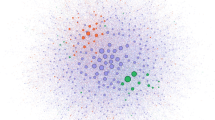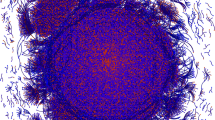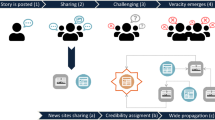Abstract
Recently, the media sphere has been found to be regularly flooded with misinformation and disinformation. Some scholars refer to such outbreaks as infodemics (Bruns, A., Harrington, S., & Hurcombe, E., Media International Australia, 2020). We are at a point where we must challenge the assumption of online spaces as emblematic of democratic ideals where participation is assumed to solely foster healthy debate in an authentic marketplace of ideas. Prominent in this subverted media arena are bots, inauthentic participants in the exchange of information, and trolls, the “Ghostwriters,” flamethrowers of the internet, whether automated or not. This problem is felt acutely in Lithuania where there are fears that a Russian information war could turn into real war or other political disruption. It is, therefore, imperative to understand the process of this media manipulation. This chapter argues that researchers will have to adapt theories and methodologies to do so by linking the theoretical groundings of mass media influence to the concept of information warfare (Cronin, B., & Crawford, H., Information Society 15:257–263, 1999), where social media chaos can warp civic participation (Zelenkauskaite, A., Creating Chaos Online: Disinformation and Subverted Post-Publics. University of Michigan Press, 2022).
Access this chapter
Tax calculation will be finalised at checkout
Purchases are for personal use only
Similar content being viewed by others
Notes
- 1.
Misinformation refers to information that is factually inaccurate, i.e. “misleading information created or disseminated without manipulative or malicious intent” (UNESCO, 2018). Misinformation is often accompanied by disinformation—where individuals, groups, and organizations deliberately aim to create confusion and discord. Disinformation is defined by “deliberate (often orchestrated) attempts to confuse or manipulate” (UNESCO, 2018).
References
Allport, F. H. (1920). The influence of the group upon association and thought. Journal of Experimental Psychology, 3, 159–182.
Anagnostopoulos, A., Kumar, R., & Mahdian, M. (2008). Influence and correlation in social networks. In Proceedings of the 14th ACM SIGKDD International Conference on knowledge discovery and data mining (pp. 7–15).
Bakshy, E., Hofman, J. M., Mason, W. A., & Watts, D. J. (2011). Everyone’s an influencer: Quantifying influence on Twitter. In Proceedings of the fourth ACM International Conference on web search and data mining (pp. 65–74).
Baños, R. A., Borge-Holthoefer, J., & Moreno, Y. (2013). The role of hidden influentials in the diffusion of online information cascades. EPJ Data Science, 21, 6.
Bedford, S., & Vinatier, L. (2018). Resisting the irresistible: ‘Failed opposition’ in Azerbaijan and Belarus revisited. Government and Opposition, 54(4), 686–714.
Bessi, A., & Ferrara, E. (2016). Social bots distort the 2016 U.S. presidential election online discussion. First Monday, 21(11). https://firstmonday.org/article/view/7090/5653
Botometer. (n.d.). Botometer. Accessed from https://botometer.iuni.iu.edu/#!/
Bruns, A., Harrington, S., & Hurcombe, E. (2020). ‘Corona? 5G? Or both?’: The dynamics of COVID-19/5G conspiracy theories on Facebook. Media International Australia. https://journals.sagepub.com/doi/full/10.1177/1329878X20946113
Burt, R. S. (1976). Positions in networks. Social Forces, 55(1), 93–122.
Canavan, J. (2005, October). The evolution of malicious IRC bots. Virus Bulletin Conference. https://www.semanticscholar.org/paper/The-evolution-of-malicious-IRC-bots-Canavan/4fb473e4741a5d9d157d075c6747a924eb22fa72
Chen, A. (2015, June 7). The agency. The New York Times Magazine. https://www.nytimes.com/2015/06/07/magazine/the-agency.html
Cohen, A. R. (1959). Some implications of self-esteem for social influence. In C. Hovland & I. L. Janis (Eds.), Personality and persuasibility (pp. 102–120). Yale University Press.
Cronin, B., & Crawford, H. (1999). Information warfare: Its application in military and civilian contexts. Information Society, 15(4), 257–263.
Daniel, F., & Millimaggi, A. (2020). On Twitter bots behaving badly: A manual and automated analysis of Python code patterns on GitHub. Journal of Web Engineering, 18(8), 1–36.
DebunkEU. (2020). About elves. https://debunk.eu/about-elves/
Deutsch, M., & Gerard, H. B. (1955). A study of normative and informational social influences upon individual judgment. The Journal of Abnormal and Social Psychology, 51(3), 629–636.
Dion, K. K., & Stein, S. (1978). Physical attractiveness and interpersonal influence. Journal of Experimental Social Psychology, 14(1), 97–108.
Dukalskis, A. (2017). The authoritarian public sphere: Legitimation and autocratic power in North Korea, Burma, and China. Routledge.
Edelstein, S., & Edwards, J. (2002). If you build it, they will come: Building learning communities through threaded discussions. eLearn Magazine, 4, 3.
Ferrara, E., Varol, O., Davis, C., Menczer, F., & Flammini, A. (2016). The rise of social bots. Communications of the ACM, 59(7), 96–104.
Fisher, S., & Lubin, A. (1958). Distance as a determinant of influence in a two-person serial interaction situation. The Journal of Abnormal and Social Psychology, 56(2), 230–238.
Friedkin, N. E. (2006). A structural theory of social influence (Vol. 13). Cambridge University Press.
Garbačiauskaitė-Budrienė, M. (2016, June 30). Garbačiauskaitė-Budrienė. Atpažink Kremliaus trolį. Delfi.lt. https://www.delfi.lt/news/ringas/lit/m-garbaciauskaite-budriene-atpazink-kremliaus-troli.d?id=71642580
Geiger, R. S. (2018). The lives of bots. arXiv preprint arXiv:1810.09590.
Golovchenko, Y., Hartmann, M., & Adler-Nissen, R. (2018). State, media and civil society in the information warfare over Ukraine: Citizen curators of digital disinformation. International Affairs, 94(5), 975–994.
González-Bailón, S., Borge-Holthoefer, J., & Moreno, Y. (2013). Broadcasters and hidden influentials in online protest diffusion. American Behavioral Scientist, 577, 943–965.
Gorwa, R., & Guilbeault, D. (2018). Unpacking the social media bot: A typology to guide research and policy. Policy & Internet, 12(2), 225–248.
Herring, S. C. (1999). Interactional coherence in CMC. Journal of Computer-Mediated Communication, 4(4).
Herring, S. C. (2003). Gender and power in on-line communication. In J. Holmes & M. Meyerhoff (Eds.), The handbook of language and gender (pp. 202–228). Blackwell.
Hjorth, F., & Adler-Nissen, R. (2019). Ideological asymmetry in the reach of pro-Russian digital disinformation to United States audiences. Journal of Communication, 69(2), 168–192.
Hovland, C. I., & Weiss, W. (1951). The influence of source credibility on communication effectiveness. Public Opinion Quarterly, 15(4), 635–650.
Huhtinen, A. M., Kotilainen, N., Särmä, S., & Streng, M. (2021). Information influence in hybrid environment: Reflexive control as an analytical tool for understanding warfare in social media. In Research anthology on fake news, political warfare, and combatting the spread of misinformation (pp. 243–259). IGI Global.
Jamieson, K. H. (2018). Cyberwar: How Russian hackers and trolls helped elect a president, what we don’t, can’t, and do know. Oxford University Press.
Kalmar, P. (2010). Bootstrapping websites for classification of organization names on Twitter. In CLEF Notebook Papers/LABs/Workshops, 2(6). http://clef2010.clef-initiative.eu/resources/proceedings/clef2010labs_submission_78.pdf
Katz, E., & Lazarsfeld, P. (1955). Personal influence: The part played by people in the flow of mass communications. The Free Press.
Khan, Z., & Jarvenpaa, S. L. (2010). Exploring temporal coordination of events with Facebook.com. Journal of Information Technology, 25(2), 137–151.
Kuk, G. (2006). Strategic interaction and knowledge sharing in the KDE developer mailing list. Management Science, 52(7), 1031–1042.
LRT. (2019, September 27). More fake news target NATO’s presence in Lithuania. https://www.lrt.lt/en/news-in-english/19/1101632/more-fake-news-target-nato-s-presence-in-lithuania
Mandernach, B. J., Gonzales, R. M., & Garrett, A. L. (2006). An examination of online instructor presence via threaded discussion participation. Journal of Online Learning and Teaching, 2(4), 248–260.
Messias, J., Schmidt, L., Oliveira, R., & Benevenuto, F. (2013). You followed my bot! Transforming robots into influential users in Twitter. First Monday, 18(7). https://doi.org/10.5210/fm.v18i7.4217
Meyer, K. A. (2003). Face-to-face versus threaded discussions: The role of time and higher-order thinking. Journal of Asynchronous Learning Networks, 7(3), 55–65.
Miller, R. L., & Benz, J. J. (2008). Techniques for encouraging peer collaboration: Online threaded discussion or fishbowl interaction. Journal of Instructional Psychology, 35(1), 87–94.
Mislove, A., Lehmann, S., Ahn, Y. Y., Onnela, J. P., & Rosenquist, J. N. (2011). Understanding the demographics of Twitter users. Proceedings of the International AAAI Conference on Web and Social Media, 5(1). https://ojs.aaai.org/index.php/ICWSM/article/view/14168
Orenstein, M. A. (2019). The lands in between: Russia vs. the West and the new politics of hybrid war. Oxford University Press.
Pearce, K. E., Vitak, J., & Barta, K. (2018). Privacy at the margins| socially mediated visibility: Friendship and dissent in authoritarian Azerbaijan. International Journal of Communication, 12(22). https://ijoc.org/index.php/ijoc/article/view/7039
Pelz, D. C. (1952). Influence: A key to effective leadership in the first-line supervisor. Personnel, 29, 209–217.
Raven, B. H. (1958). Legitimate power, coercive power, and observability in social influence. Sociometry, 21, 83–97.
Raven, B. H. (1965). Social influence and power. In I. D. Steiner & M. Fishbein (Eds.), Current studies in social psychology (pp. 371–382). Holt, Rinehart & Winston.
Romero, D. M., Meeder, B., & Kleinberg, J. (2011, March). Differences in the mechanics of information diffusion across topics: Idioms, political hashtags, and complex contagion on Twitter. In Proceedings of the 20th international conference on world wide web (pp. 695–704). ACM.
Sabbagh, D. (2020, July 30). Russia-aligned hackers since 2017 have been running anti-NATO fake news campaign. The Guardian. https://www.theguardian.com/technology/2020/jul/30/russia-aligned-hackers-running-anti-nato-fake-news-campaign-report-poland-lithuania
Schein, E. H. (1960). Interpersonal communication, group solidarity, and social influence. Sociometry, 23(2), 148–161.
Schmid, P., & Betsch, C. (2019). Effective strategies for rebutting science denialism in public discussions. Nature Human Behaviour, 3(9), 931–939.
Sengupta, K. (2019, July). Meet the elves, Lithuania’s digital citizen army confronting Russian trolls. The Independent. https://www.independent.co.uk/news/world/europe/lithuania-elves-russia-election-tampering-online-cyber-crime-hackerskremlin-a9008931.html
Simons, G. (2015). Perception of Russia’s soft power and influence in the Baltic States. Public Relations Review, 41(1), 1–13.
Smith, M., Cadiz, J. J., & Burkhalter, B. (2000, December). Conversation trees and threaded chats. In Proceedings of the 2000 ACM conference on computer supported cooperative work (pp. 97–105). ACM.
Stukal, D., Sanovich, S., Tucker, J. A., & Bonneau, R. (2019). For whom the bot tolls: A neural networks approach to measuring political orientation of Twitter bots in Russia. SAGE Open, 9(2). https://journals.sagepub.com/doi/full/10.1177/2158244019827715
Sun, B., & Ng, V. T. (2013). Identifying influential users by their postings in social networks. Springer Berlin Heidelberg.
Toepfl, F. (2018). Innovating consultative authoritarianism: Internet votes as a novel digital tool to stabilize non-democratic rule in Russia. New Media & Society, 20(3), 956–972.
Toepfl, F., & Litvinenko, A. (2018). Transferring control from the backend to the frontend: A comparison of the discourse architectures of comment sections on news websites across the post-Soviet world. New Media & Society, 20(8), 2844–2861.
UNESCO. (2018). Journalism, ‘Fake News’ & disinformation: Handbook for journalism education and training. https://unesdoc.unesco.org/ark:/48223/pf0000265552/PDF/265552eng.pdf.multi
Valeriano, B., Jensen, B. M., & Maness, R. C. (2018). Cyber strategy: The evolving character of power and coercion. Oxford University Press.
Van Dijk, T. A. (1998). Ideology: A multidisciplinary approach. Sage.
Vasiliauskaitė, N. (2021, January 11). Nida Vasiliauskaitė. Laisvės propaganda. Delfi.lt. https://www.delfi.lt/news/ringas/lit/nida-vasiliauskaite-laisves-propaganda.d?id=86197159
VDU (2021). UNESCO-UNITWIN Medijų ir informacinio raštingumo tyrimų centras. https://pmdf.vdu.lt/mokslas/mokslo-centrai/unesco-unitwin-mediju-ir-informacinio-rastingumo-tyrimu-centras/
Williams, R. S., & Humphrey, R. (2007). Understanding and fostering interaction in threaded discussion. Journal of Asynchronous Learning Networks, 11(2), 129–143.
Woolley, S. C., & Howard, P. N. (Eds.). (2018). Computational propaganda: Political parties, politicians, and political manipulation on social media. Oxford University Press.
Wright, M. (1943). The influence of frustration upon the social relations of young children. Journal of Personality, 12(2), 111–122.
Zelenkauskaite, A. (2022). Creating chaos online: Disinformation and subverted post-publics. University of Michigan Press.
Zelenkauskaite, A., & Balduccini, M. (2017). “Information warfare” and online news commenting: Analyzing forces of social influence through location-based commenting user typology. Social Media + Society, 3(3). https://journals.sagepub.com/doi/full/10.1177/2056305117718468
Zelenkauskaite, A., & Niezgoda, B. (2017). “Stop Kremlin trolls:” Ideological trolling as calling out, rebuttal, and reactions on online news portal commenting. First Monday, 22(5). https://doi.org/10.5210/fm.v22i5.7795
Acknowledgments
Author expresses gratitude to research assistant Brandon Niezgoda who helped systemize some of the literature review presented in this chapter.
Author information
Authors and Affiliations
Corresponding author
Editor information
Editors and Affiliations
Rights and permissions
Copyright information
© 2022 The Author(s), under exclusive license to Springer Nature Switzerland AG
About this chapter
Cite this chapter
Zelenkauskaite, A. (2022). Bots, Trolls, Elves, and the Information War in Lithuania: Theoretical Considerations and Practical Problems. In: Chakars, J., Ekmanis, I. (eds) Information Wars in the Baltic States. The Palgrave Macmillan Series in International Political Communication. Palgrave Macmillan, Cham. https://doi.org/10.1007/978-3-030-99987-2_7
Download citation
DOI: https://doi.org/10.1007/978-3-030-99987-2_7
Published:
Publisher Name: Palgrave Macmillan, Cham
Print ISBN: 978-3-030-99986-5
Online ISBN: 978-3-030-99987-2
eBook Packages: Political Science and International StudiesPolitical Science and International Studies (R0)




